
People of importance have schedules. They live their lives with purpose and have things to accomplish. They can’t afford to set aside their planned obligations to tend to the interruptive whims of others. They don’t wait to find out what’s going to happen before deciding what they should do; they have a vision of where they’re going and they plan ahead. Michael Phelps doesn’t swim laps only if he can find time to fit it into his daily agenda. Oprah Winfrey doesn’t go on the air without having scheduled her guests and program topics far in advance, or without having coordinated countless details in preparation for the show. Seth Godin doesn’t wait to write a blog post until he feels like it, nor does he casually think about writing a book without scheduling when he will work on it and establishing a deadline for completing it.
These people didn’t start scheduling their time once they became prominent figures. They reached their celebrity status largely because they’ve had the self-discipline to follow through on their directed planning. Sure, these people may have trainers, managers, producers, and support teams to help them with their itineraries and agendas now, but even with assistance, they still have the responsibility of making time to pursue their goals while managing day-to-day tasks and obligations. They learned to work with a schedule that would assure that they were doing the things they needed to be doing when they needed to be doing them.
How can you create a schedule that works for you?
You can create schedules for different timeframes (daily seems to be the most common), but I find it effective to start with a weekly schedule. By focusing on just one thing each day – one project or one type of task (using a specified theme of your own choosing) you can create a manageable and flexible weekly format. There will be tasks that you do daily at their appointed times, but if you don’t plan for other projects, the daily minutiae will consume your entire day, and subsequently, the entire week. And if you don’t schedule the time, you’ll never make any progress on those larger projects that need to have time designated for their attention.
Lets look at a low-tech way for creating a reusable weekly schedule that incorporates recurring tasks, and includes a designated day for working toward a long range project, one week at a time. By designing a template-like schedule, you don’t have to create an entirely new schedule every week. Similar tasks are grouped together to be done on a designated day of the week. When new tasks arise, they are incorporated into the weekly schedule on the day designated for those types of tasks. When your dry cleaning is ready to be picked up, you don’t have to adjust your existing schedule to accommodate that task, you simply add that task to the next day designated for errands.
If you have a good feel for how to structure your week, you can jump right in and label each day of the week with a preliminary theme. Alternatively, you can draft a concept schedule that describes your anticipated energy level or other factors that will affect how you plan your week. Shown here is a such a draft:
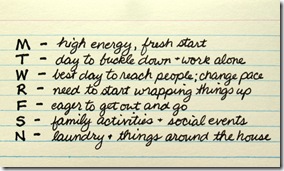
Make a list
If you want to make your schedule comprehensive, you need to identify recurring tasks as well as project-related tasks that you want to accomplish, and make sure that your themes cover those tasks. Start by listing the type of activities you engage in on a weekly basis – not necessarily the specific activities, but the type of activities you could describe as a category. Things like running errands, studying, home maintenance projects, writing, or socializing with family & friends. Add to that list projects or pursuits that you want to accomplish (write them all down, you can edit or prioritize or phase your goals as your schedule develops). Projects and pursuits might include reorganizing the garage, creating a business plan, writing a song, restoring a classic car, planning and saving for a two-week trip to Australia, reading 12 business books over the span of a year, or making a quilt. You can create a separate schedule for work and personal tasks, or you can combine your roles to focus on the system holistically – the latter is especially helpful for those who work from home or have unconventional work schedules.
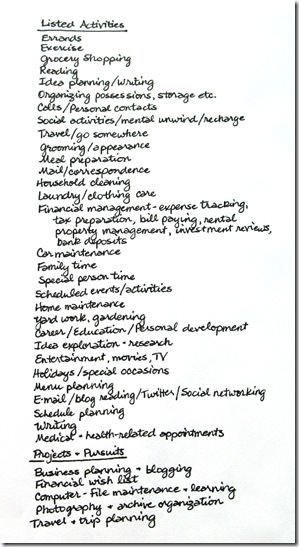
Group your weekly tasks
Categorize your list of tasks and activities by a descriptive label (such as “errands”, “correspondence”, etc.). Identify and mark similar tasks on your list by circling them, color coding, or using symbols in the margin. Think about where and when you will be doing these tasks as you create your categories. You will most likely end up with too many categories of lists on your first try. On your next revision you can look for categories that can be combined under a broader heading (for me, I eliminated the theme of “laundry/wardrobe” and reassigned the related tasks to my “catch-up day” or my “home projects day”). Some of your tasks will probably fit into more than one category – that means you either need to refine your theme description or identify the primary aspect of the task that helps you select the appropriate category.
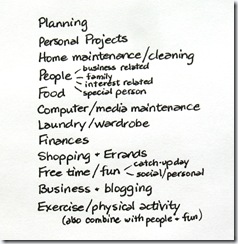
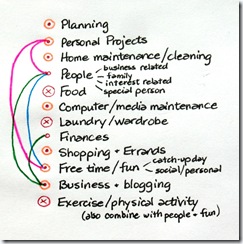
Create a daily theme
Whittle down, combine, and refine your categories until you come up with a list of 7 theme names – one for each day of the week. You will probably need to play with this step and do some editing until you find suitable descriptions for your themes – you can also go back later and revise them after you’ve created a prototype or given the plan a test drive. The important thing is to make it work for your own personal style.
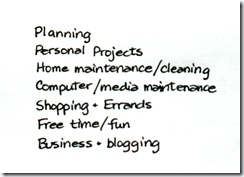
The importance of a name
The words you use when naming your daily themes can have a profound psychological and motivational effect on you, so choose your labels carefully. If the theme name “yard work day” makes you think of drudgery to be avoided, change the name to something more inspiring, like “landscape architecture day.” The naming process can be broken into a series of smaller steps. For me, it worked best to write up a bunch of descriptive words or phrases to articulate the “feel” of a particular day’s theme. I wrote something like “people/calls/correspondence/follow-up/obligations” to start with, and eventually ended up with the label of “business day,” since it’s a day for which I want to approach my tasks in a business-like manner. The cool thing about this technique is that a well-chosen name really helps to create an image and set the tone for that day’s activities. It’s almost like taking on a role, dressing the part, assuming the characteristics, and behaving in a manner consistent with that image. After creating a patchwork of descriptive words and phrases, it was easier to select the theme name that summarized my intended focus. You can also change these names later if you come up with a better title, so don’t get too perfectionistic about it.
Assign each theme to a day of the week
To make your recurring schedule work, it’s important to identify which day of the week is best suited for your particular themes of tasks and activities. If you have competing days, you’ll have to play around with your options to get the best fit. I like Sundays for planning, in anticipation of the upcoming week. I like Mondays for assigning myself the hard stuff, doing important tasks, and working through meticulous details – the tasks that I can do best when I’m fresh and ambitious.

I’ve recently realized (after 50 years of life experiences) that I need to include some kind of catch-up day in my schedule to accommodate the unexpected things that come up and interfere with my plans. This also allows me to complete tasks that take longer to finish than what I’d scheduled, and it provides some forgiveness for good intentions gone awry. If you don’t have some kind of catch-up day included, every little obstacle and diversion will put your remaining schedule behind and might make you want to write off the rest of the week as a loss, and wait to start anew on Monday. However, if you designate a weekly catch-up day and you don’t actually need the day to catch up on your tasks, you can use that time to work ahead or to do something just for you.
If you don’t know where to start – start with “Trash Day”
When a major construction project is planned and scheduled, it’s the industry standard to start with the demolition and excavation. You’ve got to clear the project area to provide room to start on the new construction or renovation. This standard also works well for planning a personal schedule. If you’re not sure which days should be assigned which themes, start with the day before your community’s scheduled trash pick-up. This will be your demolition and excavation phase. The trash pick-up will always come on that day, and will not fluctuate, even if something important comes up (except, perhaps, around certain holidays, in which case there is a planned shift in scheduled trash pick-up). So on the day before trash day, designate it for cleaning out your refrigerator, and from there, you will find that other tasks will naturally flow.
If you’re clearing out your refrigerator, it may also be a good day to schedule leftovers for dinner, a day to plan your grocery shopping list and upcoming menus; and while emptying the waste baskets in other rooms of the house, you might find another compatible task to include for that designated day. In mild weather, if you have a yard, the day before trash pick-up may also be the ideal day to bag up yard waste, assuming you don’t have yard work scheduled for some other day of the week. My “day before trash pick-up day” is Wednesday. Wednesday is also the day I chose to designate as my catch-up day. It’s a nice mid-week break that allows me to purge unwanted items, clear the decks, and regroup for a second phase of productivity for the week.
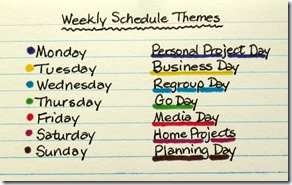
Put your plans & schedule in writing
This step is really important. If you’ve taken the time to think through the details of an effective schedule, it’s worth the extra effort to write out your final draft in a presentable form. This reinforces the notion that your schedule is of some importance, not just a whimsical exercise done for fun. Writing your schedule on card stock or on an index card makes it easy to locate for quick reference; an index card can double as a bookmark for your planner or a book. Post your schedule where you can see it or just establish it as your policy.
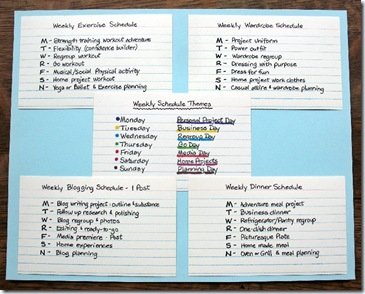
Expand the theme
Once you have a theme, you can use it to create schedules for other roles, projects, and pursuits in your life. I created a schedule for blogging, exercising, meal planning, wardrobe planning, and TV watching. Each of the subsequent schedules kept with the original scheduling theme to keep the activities compatible.
Act like a “schedule person”
For your schedule to be effective, you have to honor your commitments and expect that others will do the same – especially the activities that are scheduled for yourself. Don’t allow others to trivialize your planning by asking you to set aside your plans “just this once” to go do something fun or to help them meet their deadlines, with the rationalization that you can catch up on your things tomorrow.
Refer to your scheduling policy when coordinating tasks with others. Your daughter needs some new shoes for soccer or it’s mentioned that the car is due for an oil change? Say, “I’ll put that on the agenda for next Tuesday, when I do errands.” If you are working on a personal project which needs 2 hours of uninterrupted focus each week, go to the library or someplace where you won’t be disturbed. Tell your family and social contacts who might randomly call you that you’re not available on Thursdays – that’s your research & writing day.
Colorful visualization
I even created a themed schedule of colors for the week (this was actually an integration of a color-coded system I had previously created to help organize my “to do” lists). This may seem to take the concept of a theme to extremes, but hear me out. The colors I selected visually reinforce the emotional setting for that day’s activities and helps to create the image and enhance the story behind the theme. I also use descriptive words that remind me of my color choices and provide an association between the colors and the themes.
Now, here’s the cool part: Selecting colors allows you to color code tasks on your master list – just put an appropriately colored dot next to the associated task on your list. You’ll be able to add tasks to your list as they occur to you, in any order, then categorize them with colored dots than you can easily identify when you scan your list. Take the color coding even further by integrating color-matched folders, post-it notes, and page tabs. If you are a visual person, and you like themes, categorizing, and colors, this could be a motivating factor in getting you to create and use such a system. If not, skip the color-related mentions. As always, the best plan for you is the one that you’ll use.

Weekly scheduling time
Once you’ve developed your weekly schedule template, you will have to take time (usually once a week) to decide which specific tasks will be scheduled for the upcoming week. You only have so much time each day, and your master to do list (color-coded or not) has more items on it than you can fit into your schedule. So you have to be selective and be careful not to overbook.
Productivity studies suggest that only 40-60% of your available work hours be designated for structured activities. The rest of your day will be consumed with daily tasks and unstructured activities. As you start to do the math, you’ll quickly realize why you never seem to have enough time for everything that you want to do. But don’t let that deter you. Focus on finishing the tasks you start. You won’t be able to complete everything, but at least you’ll have the satisfaction of finishing your selected tasks. That’s better than working on twice as many projects but completing none of them. The beauty of planning a weekly schedule is that your plan will be in place before your day begins, and you won’t need to feel overwhelmed by the number of things you have to do or waste your time deciding which task should have priority at any given moment. You’ll already have that plan.
The weekly schedule and reality
Focusing on one theme per day allows you to postpone to-do tasks to their designated days without getting distracted or worrying that things will fall through the cracks. Your weekly schedule is the Plan A. It has flexibility to it, but be careful about how frequently you resort to a Plan B. If the exception becomes more of the rule, you’ll lose the benefits of having a weekly schedule. However, if unavoidably urgent issues come up, or an unexpected opportunity arises, you can often swap days, and avoid pushing your entire schedule back a day. That’s when those scheduled catch-up days come in handy.
Expect that you will have to refine your themes and revise them from time to time, due to such things as changes in seasons, life situations, or personal preferences. But don’t think of your schedule as an assignment that is imposed on you. Instead, think of your schedule as your script – a directed plan that’s standard issue for people of importance, like you.
P.S. For time planning purposes, it took me about 3 hours to set up a weekly schedule template, following the steps I’ve described. I do things slowly and very thoroughly, so adjust your own time estimate accordingly. Once your schedule is initially set up, you can do your weekly planning without so much intensity and detail. Please comment with suggestions and scheduling tips that have worked for you. I’d like to include your successful techniques in a future edition on this topic.
 Last August, Seth Godin wrote a blog post about why you should take on a project to finish during the last two weeks of August. In the US, he claims, those are the slowest two weeks of the year (though I’d guess that the end of December would claim that distinction). He suggests that while everyone else is getting in their last days of vacation and basically coasting, you should focus on finishing a 2-week project and pursue it to completion like your hair is on fire.
Last August, Seth Godin wrote a blog post about why you should take on a project to finish during the last two weeks of August. In the US, he claims, those are the slowest two weeks of the year (though I’d guess that the end of December would claim that distinction). He suggests that while everyone else is getting in their last days of vacation and basically coasting, you should focus on finishing a 2-week project and pursue it to completion like your hair is on fire.













